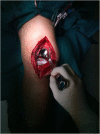Debridement, antibiotics, and implant retention combined with direct intra-articular antibiotic infusion in patients with acute hematogenous periprosthetic joint infection of the knee
- PMID: 34144684
- PMCID: PMC8214261
- DOI: 10.1186/s12891-021-04451-x
Debridement, antibiotics, and implant retention combined with direct intra-articular antibiotic infusion in patients with acute hematogenous periprosthetic joint infection of the knee
Abstract
Background: Debridement, antibiotics, and implant retention (DAIR) is the recommended treatment for acute hematogenous periprosthetic joint infection (PJI) after total knee arthroplasty (TKA). However, DAIR is associated with a high percentage of unsuccessful outcomes. Since 2007, direct intra-articular antibiotic infusion, which can provide a high concentration of intra-articular antibiotic, has been used in combination with DAIR to improve treatment outcomes among patients in our institution. This study aimed to assess the outcomes of DAIR combined with direct intra-articular antibiotic infusion in patients who presented with acute hematogenous PJI after TKA.
Methods: We reviewed the data of all patients diagnosed with acute hematogenous PJI after primary TKA (from 2008 to 2015) who received DAIR combined with direct intra-articular antibiotic infusion.
Results: In total, 15 knees in 12 patients were semi-urgently treated with this method. The mean follow-up time was 93.3 (minimum: 56) months, and the longest follow-up time was 11 years. Two patients (n = 3 knees) had a well-functioning, non-infected prosthesis 6 and 10 years after the procedure. Two patients (n = 2 knees) had re-infection 2 and 5 years after surgery, and they required two-stage revision. None of the patients were lost to follow-up. Finally, 13 (86.6%) of 15 infected knees were successfully treated with this method.
Conclusions: DAIR combined with direct intra-articular antibiotic infusion is an effective treatment for acute hematogenous PJI after TKA.
Keywords: Acute hematogenous; DAIR; Intraarticular antibiotic infusion; Periprosthetic joint infection; Total knee arthroplasty.
Conflict of interest statement
We declare no conflict of interest in this study.
Figures
References
Publication types
MeSH terms
Substances
LinkOut - more resources
Full Text Sources



